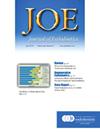Head Angulation in Cone-beam Computed Tomography Acquisition: Effect on the Diagnostic Accuracy of Vertical Root Fracture Detection
IF 3.6
2区 医学
Q1 DENTISTRY, ORAL SURGERY & MEDICINE
引用次数: 0
Abstract
Introduction
Vertical root fractures (VRFs) detection in cone-beam computed tomography (CBCT) images can be challenging when gutta-percha artifacts are present. This study aimed to evaluate how anteroposterior and laterolateral head angulations (APHA and LLHA, respectively), as well as tooth position (anterior or posterior region), influence the diagnostic accuracy of VRFs detection in CBCT for endodontically treated teeth.
Methods
Twenty single-rooted teeth were endodontically treated. A phantom was created using a human mandible and ballistic gelatin. CBCT scans of each tooth, placed in both the anterior and posterior regions, were acquired with the phantom positioned at the standard position of 0°, at APHA of 30° and 45°, and at a LLHA of 20°, totaling 320 scans. The presence or absence of VRFs was assessed by 6 examiners using a 5-point scale. Area under the receiver operating characteristic curve, sensitivity, and specificity were analyzed using two-way repeated measures analysis of variance and Sidak's post hoc test. Intra- and interexaminer agreement was evaluated using the weighted Kappa coefficient (α = 0.05).
Results
In general, the 30° and 45° APHA significantly increased area under the receiver operating characteristic curve and sensitivity values for VRF detection in both anterior and posterior regions compared to 0° and 20° LLHA. Angulations and tooth position did not influence specificity. For specificity values, the 45° APHA exhibited a significantly higher value than the other angulations in the anterior region.
Conclusions
VRFs diagnosis enhanced at 30° and 45° APHA, regardless the region.
锥束计算机断层成像中的头部角度:对垂直根骨折诊断的影响。
在锥形束计算机断层扫描(CBCT)图像中,当存在杜仲胶伪影时,垂直根骨折(vrf)的检测可能具有挑战性。本研究旨在评估前后和外侧头部角度(分别为APHA和LLHA)以及牙齿位置(前或后区域)如何影响CBCT对根管治疗后牙齿vrf检测的诊断准确性。方法:对20颗单根牙进行根管治疗。用人类下颌骨和弹道明胶制作了一个幻影。每颗牙齿的CBCT扫描,放置在前后区域,幻影定位在标准位置0°,APHA为30°和45°,LLHA为20°,共计320次扫描。6名审查员使用5分制对是否存在vrf进行评估。采用双向重复测量方差分析和Sidak事后检验分析ROC曲线下面积(AUC)、敏感性和特异性。采用加权Kappa系数(α = 0.05)评价审查员内部和审查员之间的一致性。结果:总的来说,与0°和20°的LLHA相比,30°和45°的APHA显著增加了前后区VRF检测的AUC和灵敏度值。角度和牙齿位置不影响特异性。对于特异性值,45°APHA在前区表现出明显高于其他角度的值。结论:在APHA 30°和45°时,vrf的诊断增强,与区域无关。
本文章由计算机程序翻译,如有差异,请以英文原文为准。
求助全文
约1分钟内获得全文
求助全文
来源期刊

Journal of endodontics
医学-牙科与口腔外科
CiteScore
8.80
自引率
9.50%
发文量
224
审稿时长
42 days
期刊介绍:
The Journal of Endodontics, the official journal of the American Association of Endodontists, publishes scientific articles, case reports and comparison studies evaluating materials and methods of pulp conservation and endodontic treatment. Endodontists and general dentists can learn about new concepts in root canal treatment and the latest advances in techniques and instrumentation in the one journal that helps them keep pace with rapid changes in this field.
 求助内容:
求助内容: 应助结果提醒方式:
应助结果提醒方式:


